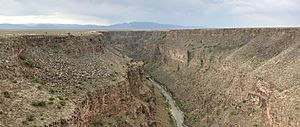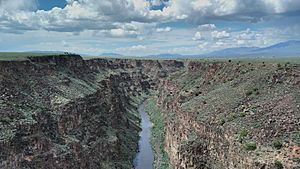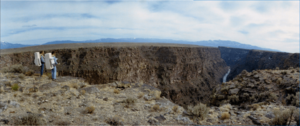Rio Grande Gorge facts for kids
The Rio Grande Gorge is a huge, deep canyon in northern New Mexico. It's where the mighty Rio Grande river has carved its way through the land for millions of years. This impressive gorge starts near the Colorado border and stretches for about 50 miles (80 km) southwest of Taos. It cuts through ancient lava flows from the Taos Plateau volcanic field. At its deepest point, just south of the famous Rio Grande Gorge Bridge, the gorge is about 800 feet (244 meters) deep!
Contents
How the Gorge Was Formed
The Rio Grande Gorge is a natural wonder, created by the power of water and earth. Over millions of years, the Rio Grande river slowly but surely carved this canyon. The area is part of a larger geological feature called the Rio Grande Rift. This rift is a place where the Earth's crust is slowly pulling apart. A mix of ancient volcanoes, shifting land, and the river eroding layers of gravel and lava all worked together to create the narrow, deep gorge we see today.
Plants and Animals of the Gorge
The canyon is like a special world, dropping 800 feet (244 meters) from the top edge down to the river. This creates many different places for plants and animals to live. You can find very old piñon and juniper trees, some of which are 500 years old!
Many animals call the gorge home, including Mule deer, Red-tailed hawks, Mountain bluebirds, Prairie dogs, and even Bighorn sheep.
The weather here is mostly dry. Summer thunderstorms are common in July and August, bringing much-needed rain. Snow can fall from November through March. Summer temperatures can range from 45°F (7°C) to 90°F (32°C), while winter temperatures can drop from 45°F (7°C) to as low as -15°F (-26°C).
A Protected River: Wild and Scenic
In 1968, the US Congress decided that the Rio Grande was a very special river. It was one of the first eight rivers in the country to be named part of the National Wild and Scenic Rivers System. This means the river and its surroundings are protected to keep their amazing natural beauty and resources safe.
The Wild and Scenic River flows through the Rio Grande Gorge Recreation Area. This area has two main parts: the Wild Rivers area in the north and the Orilla Verde area in the south. Both offer fun activities like hiking, boating, fishing, and camping for visitors.
Rio Grande del Norte National Monument
On March 25, 2013, the gorge and about 242,500 acres (98,136 hectares) of land around it became a national monument. It's now known as the Rio Grande del Norte National Monument. This special title helps protect the area's natural beauty, wildlife, and historical sites for everyone to enjoy.
Whitewater Rafting Adventures
The Rio Grande Gorge is a popular spot for whitewater rafting! The U.S. Bureau of Land Management (BLM) looks after these exciting rapids, which range from Class II (easy) to Class V (very difficult). The BLM also has two developed areas along the river with trails for hiking and biking.
Near Taos, there are two main sections for rafting:
- The Taos Box: This is a dramatic, deep part of the canyon. It's famous for its big, challenging Class IV rapids, perfect for experienced rafters.
- The Racecourse Run: This section has Class III rapids, which are a bit easier. It's a great choice for families and people trying rafting for the first time.
Ancient History and Hot Springs
The gorge holds many secrets from the past. You can find ancient petroglyphs, which are pictures carved into rocks by early people. Hidden at the bottom of the gorge, along the river, are natural hot springs. These warm pools are a relaxing treat for hikers. The area also has ruins from old settlements.
Astronauts Trained Here!
Did you know that NASA used the Rio Grande Gorge to train astronauts? In March and September 1971, astronauts practiced here because the gorge looked a lot like the landing site for the Apollo 15 mission on the Moon!
Some of the astronauts who trained here and later walked on the Moon include:
- Apollo 15 crew: David Scott and James Irwin
- Apollo 16 crew: John Young and Charlie Duke
- Apollo 17 crew: Jack Schmitt
Famous geologist William R. Muehlberger was one of their instructors, teaching them about rocks and landforms.
See also
 In Spanish: Desfiladero del Río Grande para niños
In Spanish: Desfiladero del Río Grande para niños
- Rio Grande Trail





